
Agfa-Gevaert N.V. (Agfa) is a Belgian-German multinational corporation that develops, manufactures, and distributes analogue and digital imaging products, software, and systems. It has three divisions:
Robot was a German imaging company known originally for clockwork cameras, later producing surveillance (Traffipax) and bank security cameras. Originally created in 1934 as a brand of Otto Berning, it became part of the Jenoptik group of optical companies in 1999, and specializes in traffic surveillance today.

A flash is a device used in photography that produces a brief burst of light at a color temperature of about 5500 K to help illuminate a scene. A major purpose of a flash is to illuminate a dark scene. Other uses are capturing quickly moving objects or changing the quality of light. Flash refers either to the flash of light itself or to the electronic flash unit discharging the light. Most current flash units are electronic, having evolved from single-use flashbulbs and flammable powders. Modern cameras often activate flash units automatically.

Zorki is the name of a series of 35mm rangefinder cameras manufactured in the Soviet Union between 1948 and 1978.

The Canon EOS 20D is an 8.2-megapixel semi-professional digital single-lens reflex camera, initially announced on 19 August 2004 at a recommended retail price of US$1,499. It is the successor of the EOS 10D, and was succeeded by the EOS 30D in August 2006. It accepts EF and EF-S lenses and uses an APS-C sized image sensor.

The Kia K5, formerly known as the Kia Optima, is a mid-size car manufactured by Kia since 2000 and marketed globally through various nameplates. First generation cars were mostly marketed as the Optima, although the Kia Magentis name was used in Europe and Canada when sales began there in 2002. For the second-generation models, Kia used the Kia Lotze and Kia K5 name for the South Korean market, and the Magentis name globally, except in the United States, Canada and Malaysia, where the Optima name was retained until the 2021 model year. The K5 name is used for all markets since the introduction of the fifth generation in 2019.

The Canon A-1 is an advanced-level single-lens reflex (SLR) 35 mm film camera for use with interchangeable lenses. It was manufactured by Canon Camera K. K. in Japan from April 1978 to 1985. It employs a horizontal cloth-curtain focal-plane shutter with a speed range of 30 to 1/1000 second plus bulb and flash synchronization speed of 1/60 second. It has dimensions of 92 millimetres (3.6 in) height, 141 millimetres (5.6 in) width, 48 millimetres (1.9 in) depth and 620 grams (22 oz) weight. Unlike most SLRs of the time, it was available in only one color; all black. The introductory US list price for the body plus Canon FD 50 mm f/1.4 SSC lens was $625; the camera body was generally sold with a 30–40% discount.
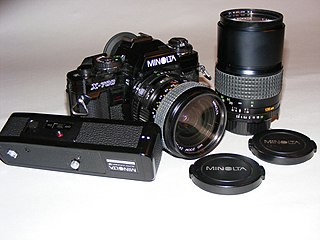
The Minolta X-700 is a 35 mm single-lens reflex film camera introduced by Minolta in 1981. It was the top model of their final manual-focus SLR series before the introduction of the auto-focus Minolta Maxxum 7000.

The Agfa Optima Flash is a fixed-lens 35 mm viewfinder camera manufactured in Germany by Agfa from 1981 to 1983. It belongs to the Agfa Optima series, features the same big red Sensor shutter-release and large viewfinder as any other in the series, with some improvements and a built-in flash.
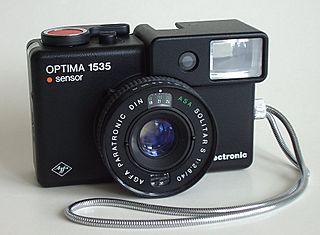
The Agfa Optima 1535 Sensor is a 35 mm rangefinder camera manufactured by the German company Agfa in 1977.
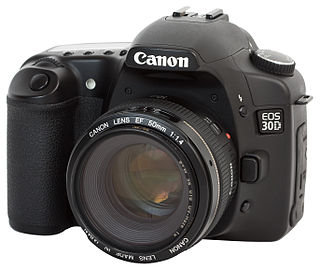
The Canon EOS 30D is an 8.2-megapixel semi-professional digital single-lens reflex camera, initially announced on February 21, 2006. It is the successor of the Canon EOS 20D, and is succeeded by the EOS 40D. It can accept EF and EF-S lenses, and like its predecessor, it uses an APS-C sized image sensor, so it does not require the larger imaging circle necessary for 35 mm film and 'full-frame' digital cameras.
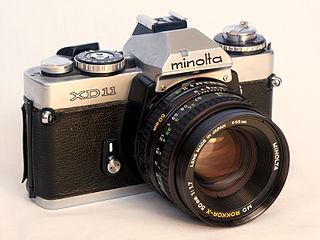
The Minolta XD-7 is a 35mm SLR film camera manufactured by Minolta from 1977 until 1984. It was Minolta's first SLR camera to feature both shutter priority and aperture priority automatic exposure modes. The camera also offered fully metered manual exposure as well as depth of field preview and an eyepiece shutter. Also, included were fully mechanical "O" and bulb settings, which allowed it to operate without a battery. The XD-7 was the top-of-the-line Minolta camera when it was in production and retains a reputation for quality. It was Minolta's last metal-bodied SLR design before the company switched to plastic with the X-700.
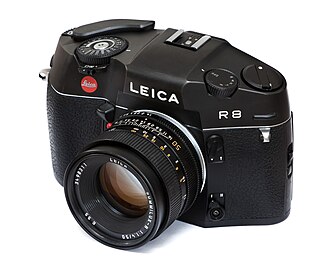
The Leica R8 & R9 are manual focus 35 mm single-lens reflex cameras produced by the German firm Leica as the final models of their R series. Development of the R8 began in 1990: the camera was introduced at the 1996 photokina trade show, and was succeeded by the similar Leica R9 in 2002.

The Minolta A-mount camera system was a line of photographic equipment from Minolta introduced in 1985 with the world's first integrated autofocus system in the camera body with interchangeable lenses. The system used a lens mount called A-mount, with a flange focal distance 44.50 mm, one millimeter longer, 43.5 mm, than the previous SR mount from 1958. The new mount was wider, 49.7 mm vs. 44.97 mm, than the older SR-mount and had a longer flange focal distance making old manual lenses incompatible with the new system. Minolta bought the autofocus technology of Leica Correfot camera which was partly used on the a-mount autofocus technology. The mount is now used by Sony, who bought the SLR camera division from Konica Minolta, Konica and Minolta having merged a few years before.

Most digital cameras support the ability to choose among a number of configurations, or modes, for use in various situations. Professional DSLR cameras provide several manual modes; consumer point-and-shoot cameras emphasize automatic modes; amateur prosumer cameras often have a wide variety of both manual and automatic modes.

A selenium meter is a light-measuring instrument based on the photoelectric properties of selenium. The most common use of such light meters is measuring the exposure value for photography. The electric part of such a meter is an electromagnetic measuring instrument which is connected to the anode and cathode of a selenium photo cell that produces more or less electric power when exposed to more or less light. The optical part of such a meter is a window in front of the photo cell's light-sensitive side. The window's surface is usually structured like a honeycomb made of convex lenses. This type of window helps to bundle the light coming from the direction in which the photo cell is pointed. The mechanical part of a selenium meter is an analog calculator which accepts exposure value and film speed as input parameters for showing the possible aperture and shutter-speed combinations for correct exposure.
This article discusses the cameras – mainly 35 mm SLRs – manufactured by Pentax Ricoh Imaging Corp. and its predecessors, Pentax Corporation and Asahi Optical Co., Ltd.. Pentax must not be confused with Pentax 6x7 or Pentax 67 which are 120 medium format 6x7cm film cameras.

The Nikon D3S is a 12.1-megapixel professional-grade full frame (35mm) digital single-lens reflex camera (DSLR) announced by Nikon Corporation on 14 October 2009. The D3S is the fourth camera in Nikon's line to feature a full-frame sensor, following the D3, D700 and D3X. It is also Nikon's first full-frame camera to feature HD (720p/30) video recording. While it retains the same number of pixels as its predecessor, the imaging sensor has been completely redesigned. Nikon claims improved ultra-high image sensor sensitivity with up to ISO 102400, HD movie capability for extremely low-lit situations, image sensor cleaning, optimized workflow speed, improved autofocus and metering, enhanced built-in RAW processor, quiet shutter-release mode, up to 4,200 frames per battery charge and other changes compared with the D3. It was replaced by the D4 as Nikon's high speed flagship DSLR.

Canon EOS 1100D is a 12.2-megapixel digital single-lens reflex camera announced by Canon on 7 February 2011. It is known as the EOS Kiss X50 in Japan and the EOS Rebel T3 in the Americas. The 1100D is Canon's most basic entry-level DSLR, and introduces movie mode to other entry level DSLRs. It replaced the 1000D and is also the only Canon EOS model currently in production that is not made in Japan but in Taiwan, aside from the EOS Rebel T4i.
Leica R4, R5, R6, R7 were 35 mm SLR cameras manufactured by Leica between 1980 and 1997.

















